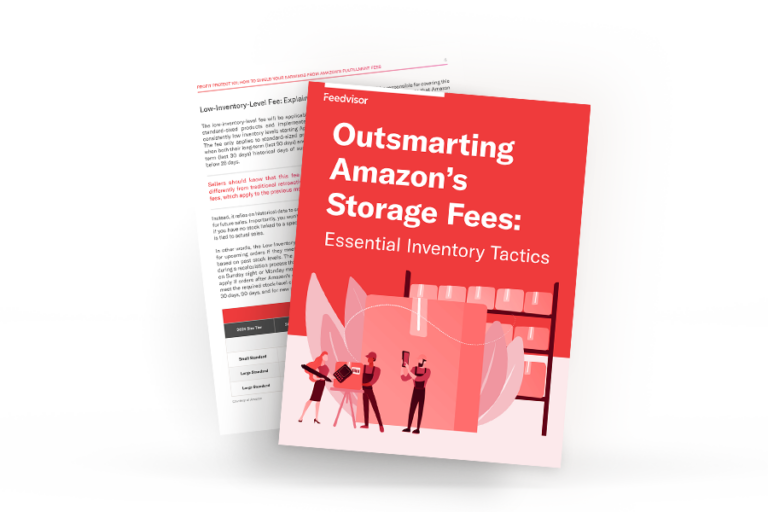Resources - Blog
Why Private Labels Need Repricing Technology to Manage Inventory Health

Maintaining healthy inventory levels stands as a formidable challenge for merchants of all stripes. For Private Labels, challenges range from storage fees to brand visibility, creating a unique set of hurdles that significantly impact profitability and brand visibility.
In this blog, we’ll delve into the importance of managing inventory health and explore how repricing technology offers solutions to address these challenges, benefiting all types of businesses — including Private Labels.
How Does Inventory Pose a Problem for Private Labels?
An often-shared challenge by those who sell on Amazon revolves around complex storage fees. Take the low-inventory-level fee, for instance. The fee penalizes those who have too little stock, necessitating all merchants now strike the right balance between too little and too much inventory — a delicate act comparable to walking a tightrope.
The low-inventory-level fee exacerbates the already existing strain on Private Labels’ bottom lines, heightening the threat of costly storage fees that often eat away at profits. Amid reports of Amazon deducting 45 cents from every dollar earned through third-party sales, it has become crucial for Private Labels to safeguard their earnings against a surge in complex, costly storage fees, including:
- High-returns processing fee: A charge on high-return rate items across all categories, except apparel and footwear, aimed at covering operational expenses associated with returns and minimizing waste.
- Inbound placement fee: A fee aimed to offset Amazon’s expenses in distributing products across fulfillment centers nationwide.
- Storage Utilization Surcharge: A charge incurred when a seller keeps inventory units in an Amazon warehouse longer than 26 weeks,
- Aged Inventory Surcharge: A monthly charge assessed using an inventory snapshot on the 15th day of each month. The Aged Inventory Surcharge is only charged on inventory units stored in an FBA center longer than 180 days.
With so many FBA fees to watch out for, it’s easy for Private Labels to lose track of managing their inventory health and see their IPI be dinged. The consequences for this are detrimental — costly storage fees, risk of account suspension, and restriction to certain features are all risks you take when your IPI score takes a hit.
A unique challenge faced by those who own the Buy Box, often Private Labels, is the potential loss of key product placements when inventory runs out. If a product becomes unavailable, it can significantly disrupt your ad campaign, depending on its type.
- Sponsored Brand campaigns: The advertised product’s ASIN will be removed from the campaign.
- Sponsored Product campaigns: The campaign will stop serving impressions if the product is out of stock — and the Buy Box or Featured Offer is unavailable.
For Private Labels, campaigns play a crucial role in boosting brand visibility, given their lesser-known status compared to established brands. Losing a campaign for a product can drastically reduce customer traffic — a vital component of success on Amazon.
Inventory-Aware Repricing Technology: The Solution for Private Labels
The remedy lies in proactively avoiding inventory issues that can significantly harm your business, affecting everything from brand visibility to financial performance. To anticipate and address potential problems, merchants need to track their inventory levels and overall health closely. Additionally, when issues emerge, it’s crucial to understand the demand curve and price elasticity. By doing so, you can pinpoint the optimal price point that boosts demand and enhances sales velocity.
Yet handling inventory health, identifying and resolving issues, can be both time-consuming and perplexing. Today, many brands harness the potential of AI to streamline inventory optimization and proactively address issues. In fact, nearly half of brands rely on AI for inventory management, as per our sixth annual e-marketplace report.
But while many AI solutions offer data, the missing link is actionable real-time strategies per ASIN that only AI can achieve — truly optimizing the pace at which your products move. Navigating your inventory health is no longer about responding to market changes; it’s about predicting and influencing them.
This is where Feedvisor’s AI-driven technology comes into play, going beyond simple insights to empower sellers with actionable strategies. With its latest update, Feedvisor has enhanced its prowess in optimizing pricing and profitability to allow merchants to fine-tune their price velocity, preventing inventory issues. By merging smart algorithms, competitive signals, and real-time inventory insights, it swiftly adapts to market shifts, intelligently adjusting prices in real-time to discover the optimal point for achieving the desired level of sales and inventory velocity, including:
- Understocking: Slowing down sales to avoid stock depletion.
- Overstocking: Identifying the optimal price point to boost demand, accelerating sales velocity for quicker stock turnover.
Feedvisor’s AI repricer takes a proactive approach, anticipating inventory issues and enabling sellers to resolve them beforehand. Better still, unlike rule-based repricers, Feedvisor’s repricin technology is dynamic. It is able to factor in and adapts to constantly changing market conditions and fluctuating inventory levels at a granular level, allowing it to intelligently adjust prices and avoid fees in near real time while maximizing margins and selling at optimal prices.
However, managing inventory levels is only part of the equation. It’s equally crucial to verify that your campaigns are functioning effectively and reaching the appropriate audience. With AI-powered product and audience targeting alongside insights into inventory health, Feedvisor’s advanced advertising optimization guarantees that your campaigns are reaching the right audience at the right moment, thereby maximizing brand visibility in a fiercely competitive marketplace.
The result of Feedvisor’s inventory-aware, holistic solution is continuous brand visibility through AI-powered, optimized campaigns devoid of inventory-related performance setbacks.
Final Thoughts
As Private Labels continue to navigate the intricate landscape of inventory management, the importance of leveraging innovative solutions like repricing technology cannot be overstated. With Feedvisor’s powerful integrated solution, businesses are equipped to tackle challenges with unparalleled precision.
By delving into market dynamics and inventory levels at a granular level, Feedvisor empowers merchants to not only minimize fees but also maximize profits. Take the first step towards optimizing your inventory levels today with a free, 14-day trial.


